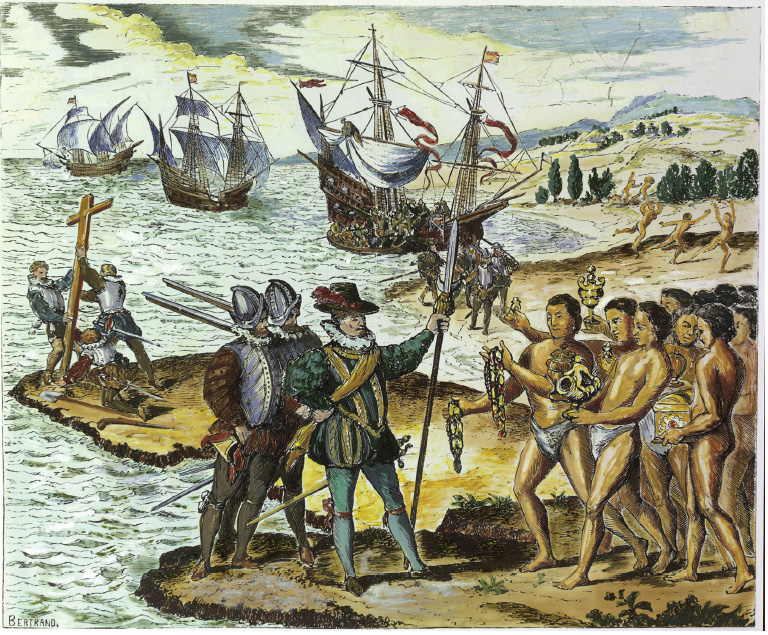The first meeting of Columbus and his Spanish explorers with the natives of the Caribbean was one to be remembered. Posterity has pictured this scene as one of happy explorers sharing food with the natives; but the truth of that first encounter, and its aftermath for the natives, was far from happy. Through the exchange, the natives received a number of diseases for which they had no immunities; and one of the largest demographic disasters the world has ever seen was the result. But the disease syphilis was also exchanged, between the New World and the Old World. The nature of this exchange of syphilis, though, is full of debate and speculation concerning its origins.

Syphilis was one of the most notable examples of New World diseases that traveled to the Old World in what historians now call the Columbian Exchange. There are two different theories for how syphilis was spread. The Columbian hypothesis claims that syphilis was spread by Columbus and his crew on their voyage back to the Old World. Once they contracted it from natives in the Americas, the crew then went back to the Old World. The evidence that supports this hypothesis is the assumption that Columbus’s crew members, once returned back to Spain, joined Spain’s war effort in Naples, exposing the disease to local prostitutes. Once exposed to syphilis, the disease was spread quite easily from the prostitutes to other soldiers and locals, thus increasing the spread of syphilis in the Old World. This explanation for the spread of syphilis is possible because some of Columbus’s crew did in fact join the war effort against Naples and most likely they did mingle with the locals there causing the spread of syphilis.1
The other theory, the Pre-Columbian hypothesis, was that syphilis had always been an Old World disease, but its spread was only exacerbated through the interaction of the natives and Europeans during the Columbian Exchange. This second theory is plausible since there is evidence of pre-Columbian Old World skeletons that show scars similar to syphilis scars. What this means is, since the skeletons from the Old World have scars and written accounts of symptoms similar to syphilis that pre-date the first exchange between Columbus and the Americas, syphilis could have possibly been an Old World disease. Now this theory of syphilis’ origin is a matter of syphilis being yet another disease that was spread from the explorers. Both of these hypotheses are plausible.2
Although these two theories for the origin of syphilis have been debated for decades, a less know third theory has emerged. This third theory suggests that syphilis was both an Old World and a New World disease. Syphilis is thought to “evolved simultaneously with human.”3 In other words, when the respectively different populations of humans evolved, the disease known as syphilis grew with the population in both hemispheres. This theory, though, is mostly unknown because of the two older and more established theories, which have dominated the discussions on syphilis’ origins. This third theory puts an interesting twist on this long debate.4
Through the exchange of syphilis, the lives of natives and explorers were changed in a drastic way. The picture of happy natives and explorers sharing food is one everyone has seen but the different narrative of the debate of syphilis’ origins is one many have not seen. The three theories of syphilis are all very real and possible, which is why the debate of syphilis is such a topic that can cause arguments. The debate over syphilis’ origins is one that will most likely be researched and hypothesized over for many years to come.
- Nathan Nunn and Nancy Qian, “The Columbian Exchange: A History of Disease, Food, and Ideas,” The Journal of Economic Perspectives 24, no. 2 (2010): 166-167. ↵
- Nathan Nunn and Nancy Qian, “The Columbian Exchange: A History of Disease, Food, and Ideas,” The Journal of Economic Perspectives 24, no. 2 (2010): 167. ↵
- Brenda J. Baker et al., “The Origin and Antiquity of Syphilis: Paleopathological Diagnosis and Interpretation and Comments and Reply,” Current Anthropology 29, no. 5 (1988): 703–706. ↵
- Brenda J. Baker et al., “The Origin and Antiquity of Syphilis: Paleopathological Diagnosis and Interpretation and Comments and Reply,” Current Anthropology 29, no. 5 (1988): 704. ↵



53 comments
Hali Garcia
This is a very interesting article. Syphilis has always been a mystery to me and this article makes me think even more. All three theories are quite possible because it could very well have already been present for both sides. I can understand how it can be viewed that the Europeans brought the disease with them because of the results in the New World and vice versa. But I also wonder if the new environment could have also played a factor.
Christopher Hohman
Nice article. The origins of this disease will always remain a mystery. I had always thought that the natives gave it to the first explorers from Europe, but after reading this article I now know that there is more than one other explanation. It may have always existed in Europe, but may have always been a disease that was just exacerbated by European contact with Native Americans. Still it would be interesting to know for sure.
Diego Terrazas
Europeans brought many things to the New World and the biggest one of them all was disease. It is interesting that a disease dates so far back. I wonder why diseases were transmitted to the Native Americans from the Europeans and not the other way around. Perhaps it was because Native Americans did not live in heavy populated cities that promoted the growth of bacteria and thus disease.
Brianna Nevarez
I had no idea that this disease had an ‘origin story’. I guess there is always an origin story for all the diseases humanity has ever been exposed to. This one just is not as popular as the others. If this was an Old World disease, which I think is the most plausible explanation, then I would not be surprised. The fact that Europeans were the reason for the collapse of the Aztec empire and the introduction of smallpox, I am not fazed that they introduced this disease to the Americas.
Yazmin Garza
I personally believe that Columbus and his crew were the ones who spread the disease to the natives. I think it is a shame that Columbus ‘discovered’ the New World, and tainted it with his European diseases, and stained it with the blood of the natives. I believe that the skeletons with scars from syphilis and the records of the symptoms are enough to prove that the Europeans were the culprits of such a horrible disease, and it is their fault that it spread to the native people of the New World.
Danielle Slaughter
This article introduced me to things I didn’t know about a disease I never understood much about until high school anatomy class. I found it interesting that there are so many theories regarding both the origin and spread of syphilis, especially that third one. It got me thinking of other contagious diseases that are found worldwide, such as rabies, which is endemic to all mammals regardless of global origin. Maybe syphilis truly did evolve right along wih us? Wonderful and insightful article.
Lamont Traylor
I’ve actually heard a few different theories on how syphilis came about, some people swear that it was a government made experiment and others like my US history teacher would tell us that the men aboard the ships of Columbus would have sex with sheep and the disease came about that way. Either way, I hope that people never do either one of those things again.
Bictor Martinez
I have heard on how the Columbian Exchange help to exchange food, spices, clothes, and diseases but now such a powerful disease such as syphilis. If I’d have to choose a theory on how syphilis spread across the old world, I will lean moreover to the first theory. The natives contaminated Columbus’s crew with the disease and from there they brought the disease to the old world. Despite of all these great theories, we will never be 100% sure on how syphilis contaminated the old world.
Lynsey Mott
Although I have heard the word syphilis in TV shows like Greys Anatomy, they didn’t really get into what it means and how It effects the people who have it. It was interesting to know that peoples immune systems were basically garbage when it came to going somewhere new, i.e. Columbus and its natives. Its like being around kids who all bring different germs, and there is bound to be a least one person to get sick out of all of them, if not all.
Diego Aguilera
All we can do is hope this disease goes away someday. Thank God, with all this research and technology we have now there is hope we can find a cure to stop this among other diseases out there. Its crazy to see how it came from so long ago and where we are now. This is a great article and I love being able to go back to read these articles.